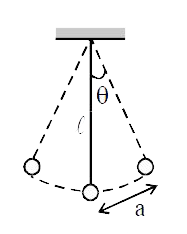Y1=asinωt तथा Y2=asin(ωt+δ) वाली दो तरंगों व्यतिकरण उत्पन्न कर रही है तब परिणामी तीव्रता -
a2cos2δ/2
2a2cos2δ/2
3a2cos2δ/2
4a2cos2δ/2
The correct Answer is:D
Step by step video, text & image solution for Y_(1)=a sin omegat तथा Y_(2) =a sin (omegat+delta) वाली दो तरंगों व्यतिकरण उत्पन्न कर रही है तब परिणामी तीव्रता - by Physics experts to help you in doubts & scoring excellent marks in Class 12 exams.
Updated on:21/07/2023Topper's Solved these Questions
- तरंग प्रकाशिकी BOOK - ALLEN HINDICHAPTER - तरंग प्रकाशिकी EXERCISE - EXERCISE-IV (Assertion & Reason)
15 Videos
- तरंग प्रकाशिकी BOOK - ALLEN HINDICHAPTER - तरंग प्रकाशिकी EXERCISE - EXERCISE-II (Previous Year Questions)
32 Videos
- तरंग गति तथा डॉप्लर प्रभाव BOOK - ALLEN HINDICHAPTER - तरंग गति तथा डॉप्लर प्रभाव EXERCISE - EXERCISE-IV (Assertion & Reason)
34 Videos
- दोलन BOOK - ALLEN HINDICHAPTER - दोलन EXERCISE - EXERCISE-IV
14 Videos
Similar Questions
कथन : यदि YDSE में श्वेत प्रकाश का प्रयोग किया जाये, तो केन्द्रीय दीप्त फ्रिन्ज, श्वेत होगी
कारण : क्योंकि सभी तरंगें, केन्द्र स्थिति पर शून्य क्रम का उच्चिष्ठ (Maxima) उत्पन्न करती है।
View Solutionयंग द्वि-झिरी प्रयोग में, फ्रिज क्रम को m द्वारा प्रदर्शित किया जाता है, तो फ्रिज चौड़ाई :-
View Solutionकथन : अप्रगामी तरंग प्रारूप में दो क्रमागत निस्पंदों के बीच माध्यम के कण समान कला में एवं भिन्न-भिन्न आयाम से कम्पन करते हैं।
कारण : अप्रगामी तरंग में, कम्पनों का आयाम कणों की स्थिति पर निर्भर नही करता है।
View Solutionकथन : केवल a<<l के लिए सरल लोलक की गति सरल आवर्त होती है।
कारण : अल्प कोणीय विस्थापन के लिए सरल लोलक की गति सरल आवर्त होती है।
View SolutionTwo simple harmonic motion y_(2) A sin omegat and y_(2)=A cos omegat are superimposed on a particle of mass m . The total mechanical energy of the particle is:
View SolutionTwo particle are executing simple harmonic motion. At an instant of time t their displacement are y1=acos(ωt) and y2=asin(ωt)
Then the phase difference between y1 and y2 is
View Solutionचार स्वतन्त्र तरंगों के समीकरण हैं y1=a1sinωt,y2=a2sin2ωt,y3=a3cosωt तथा y4=a4sin(ωt+π3)
इनमें से किन तरंगों के मध्य व्यतिकरण संभव है ?
View SolutionTwo SHMs are respectively represented by y_(1)=a sin (omegat-kx) and y_(2)=b cos(omegat-kx) . The phase difference between the two is
View Solutionदो प्रकाश तरंगें y1=a1sinωt तथा y2=a2cos(ωt+ϕ) के मध्य पथान्तर कितना होगा?
View SolutionFour light sources produce the following four waves
(i) y1=asin(ωt+ϕ1)
(ii) y2=asin2ωt
(iii) y3=a‘sin(ωt+ϕ2)
(iv) y1=asin(ωt+ϕ1)
Superposition of which two waves give rise to interference?
View SolutionTwo waves y_(1) = a sin (omegat - kx) and y_(2) = a cos(omegat - kx) superimpose at a point :
View Solutiony_(1)=Asin(omegat-kx)&y_(2)=Asin(omegat-kx+delta) : these two equations are representing two waves. Then the amplitude of the resulting wave is
View SolutionTwo particles are executing simple harmonic motion. At an instant of time t their displacement are
y1=acos(ωt)
and y2=asin(ωt)
Then the phase difference between y1 and y2 is:
View SolutionFour light sources produce the following four waves
(i) y1=asin(ωt+ϕ1)
(ii) y2=asin2ωt
(iii) y3=a‘sin(ωt+ϕ2)
(iv) y1=asin(ωt+ϕ1)
Superposition of which two waves give rise to interference?
View SolutionTwo particle are executing SHMs .The equations of their motions are y_(1)=10"sin"(omegat+(pi)/(4)) " and "y_(2)=5 "sin"(omegat+(sqrt(3)pi)/(4)) What is the ratio of their amplitudes.
View Solution
